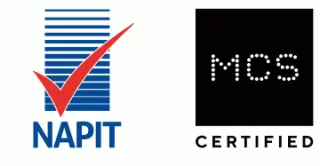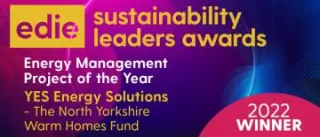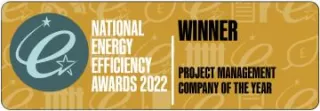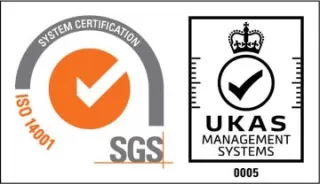External Wall Insulation
What is external wall insulation?
External wall insulation, also known as EWI and external solid wall insulation, is a type of insulation that is attached to the outside of your walls. Two layers of material are used – one to offer insulation, and an outer layer of mineral or synthetic render to protect against weather and provide a decorative finish.
Installing EWI will add around 100mm to your house, depending on the thickness of insulation used.
| Property Type | Average Cost | Av Energy Savings | Av Cost Savings |
|---|---|---|---|
| Mid Terrace House | £4 – £6,000 | 690kg CO2/year | £160 |
| Semi Detached House | £8 – £10,000 | 1,120kg CO2/year | £255 |
| Detached House | £12 – £14,000+ | 1,870kg CO2/year | £425 |
*Figures taken from the Energy Saving Trust
What buildings can external wall insulation be used on?
EWI is suitable for any building with solid walls. These can be:
- Older properties built before 1930 that have solid brick walls
- System built (concrete) properties that tend to have been built between the 1930s and 1980s
- Solid wall properties with timber or steel frames
Houses built with cavity walls do not need EWI because they already have a space within the walls that insulation can be injected in to. Many properties with cavity walls have already been insulated apart from what are known as “hard to treat” cavity walls that require more specialist treatment.
How do I tell if I have solid walls?
If your walls are brick, then the best way to tell if they are solid walls or cavity walls is to look at the brick pattern on the outside of the house.
If the bricks are all rectangular and laid end-to-end then the wall is probably cavity. If some of the bricks are laid with the square end facing out then it is probably a solid wall.
If the brick work is covered up (e.g. with a pebble dash render) then it can be harder to identify.
Properties of a non-traditional construction, such as system built or timber framed houses, are likely to have solid walls.
If you have an Energy Performance Certificate (EPC) for your home, then you will be able to see what type of construction the walls are. This is typically listed on the second page of the document.
Check the Landmark register to see if your home has an EPC
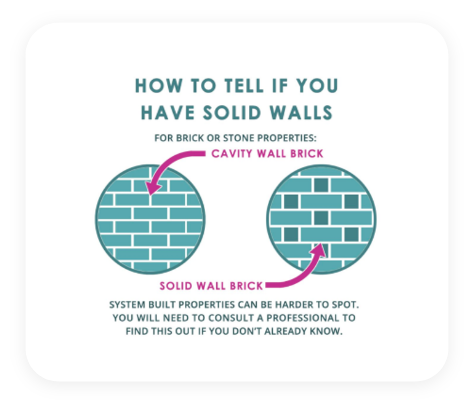
How does external wall insulation insulation work?
Heat is lost from a building in three ways:
- Conduction
- Convection
- Radiation
It travels through the walls, roof, floor, windows and doors. EWI reduces heat loss through your walls.
How does EWI stop:
Conduction
By using an insulating material that is bad at conducting heat and choosing the right thickness for this material. This helps lock the heat inside your home.
Convection
The insulating material has small voids or air pockets to contain air movement. EWI normally uses an expanding polystyrene slab which contains thousands of trapped air pockets.
Radiation
EWI systems use surfaces that emits little radiant energy and absorb a very small percentage of the radiant energy falling on to it.
Can EWI help prevent condensation?
EWI helps to prevent condensation because it traps heat inside rooms so that internal walls are not as cold.
When walls are colder they attract water in the air which is how condensation appears.
How much heat is saved?
What is a U-value?
A U- value measures how effective a material is as an insulator. The lower the U-value the better insulator the material is. So lower U-values also mean that more heat is saved.
The insulation properties of an EWI system are influenced by the following factors:
- The material used
- The thickness of the insulation used
- The thickness of your current walls
Below are estimate improvements from Ofgem:
Average U-value improvements for a typical domestic property when EWI is installed:
| Insulation Thickness | U-value Improvement | Av Energy Savings | Av Cost Savings |
|---|---|---|---|
| 50mm | 100mm | 150mm | 200mm |
| From 2.1 to 0.6 | From 2.1 to 0.35 | From 2.1 to 0.25 | £From 2.1 to 0.18 |
*Figures taken from Ofgem data, based on properties built in England and Wales before 1967 or Scotland before 1965 of a solid brick construction.
Please note that thicker insulation boards can sometimes be impractical and compromise access to windows and doors. As a general rule, 100mm insulation boards are typically installed.
Some EWI systems are manufactured to be thinner whist providing better U-value savings. However, these tend to be more expensive.
How long does it take to install external wall insulation?
It can take a few days to fit EWI depending on the size of your property. Most installations are completed within 14 working days.
Are there any issues with installing EWI?
Fitting EWI is very weather dependant and can only really be installed during dry spells due to the chemical cure in the render and topcoat. Sometimes installations may take longer to complete during the winter or if the forecast is poor.
Is planning permission required?
In some instances you may need planning permission from your local council; however, this tends to be rare. If you live in a listed building or a conservation area then you will need to seek advice from your local planning office before an installation is scheduled. YES will do planning application for any grant applications.
Should I get external wall insulation or internal wall insulation?
In general, EWI is more versatile than internal wall insulation (IWI) in terms of thickness, and therefore also in terms of energy saving and warmth provided. IWI will shrink the size of your rooms, so you’re restricted as to how thick you can have it.
As a rule, IWI is no worse at insulating than EWI, however it can work out more expensive after re-decorating and re-plastering. It also won’t provide the added weather protection that EWI offers. EWI is less disruptive to your everyday life during installation.



